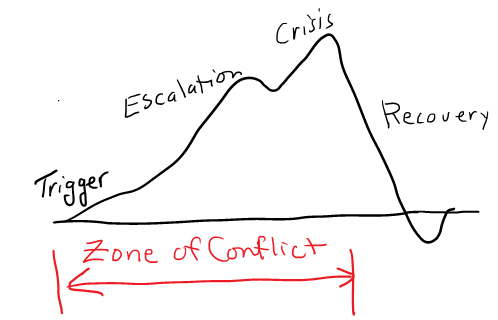When you find yourself in difficult conversation, are you quick to the defensive? Or, maybe you lash out, unintentionally, with a few harsh words to the other person? Sometimes we need a little help, to get ourselves under control. There must be an ‘app’ that can help, right?
A recent post on IdeaConnection, Awesome innovations to improve health outcomes, highlighted a Smart Monitoring Shirt for runners, by Cityzen Sciences (a French company). Here’s their rocking promo clip:
(Video not displaying? Watch it on YouTube)
The shirt has me speculating on possibilities. Why not something similar, bio-feedback wise, to monitor our emotions, and which we use to help us keep our conflict in check?
The arousal cycle
Something triggers you. Your lizard kicks in. Eventually you wind down, recover, and maybe even a bit more, a wee bit of depression. As your anger grows, escalates, essentially you are in what I call your zone of conflict. What if you could reduce that zone, both in amplitude and intensity?
Digitizing our emotional state for personal conflict management
Imagine. An unpleasant situation presents itself, and building on the sensing shirt concept:
- a biometric device attached to your body picks up your physiological response; e.g., elevated heart rate, quickness of breath…
- the device messages an app, in your phone or watch (or google glass!)
- the app processes the signal, and alerts you, through a graphical display, to your changed emotional state
- you act appropriately
The premium version would include:
- readouts could be compiled over time, integrated with other data (e.g situation parameters), and be your own personal ‘big data’…. your conflict coach!
And, even more radical:
- the biometric device is imbedded under your skin
- when activated by you, the device/application automatically releases chemicals to moderate imbalance
So what?
Working with the biofeedback from the device, we can learn, train ourselves, to respond faster and appropriately, towards reducing the lag between signal received (“negative input”) and appropriate action (positive output); a reduction in our zone of conflict. Who wouldn’t want that?
Caveat: Of course, context is queen. Analyzing your bio-feedback app may not be the thing to do if you’re surrounded by a pack of hyenas on the Serengeti.
What do you think. What’s the future for machine/human interface in the field of conflict resolution?
Happy Valentine’s Day!


Speak Your Mind